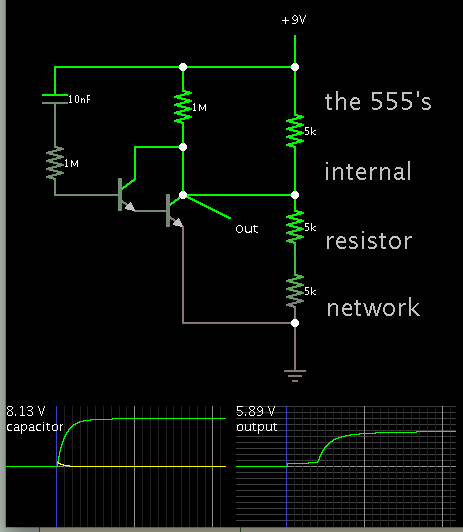ahahn
Newbie level 3

Hi,
I want to slowly decrease the frequency of a 555 astable oscillator over time, until it reaches a certain end frequency. The oscillator should start at a particular frequency but the frequency can start decreasing as soon as the timer is powered on.
My initial thought was to use the 555's control pin. By charging a capacitor through a resistor, I could increase the voltage at the pin. Unfortunately, the internal voltage divider (5k/10k ohms) is too low impedance for the R value needed to charge the capacitor (1M-10M ohms). So I tried using an LM317 to generate a voltage at the control pin, while slowly increasing the LM317 voltage with a soft start circuit (**broken link removed**). Unfortunately the LM317 doesn't get over 1.9V this way. (Transistor is a BC327 instead of the 2N2907, Vsupply is 9V, the capacitor is 10uF, the resistor R3 from the soft start schematic is 470k).
Any ideas how I could do this? Eventually I want to make the 555 take twenty or thirty minutes to reach the final frequency.
I want to slowly decrease the frequency of a 555 astable oscillator over time, until it reaches a certain end frequency. The oscillator should start at a particular frequency but the frequency can start decreasing as soon as the timer is powered on.
My initial thought was to use the 555's control pin. By charging a capacitor through a resistor, I could increase the voltage at the pin. Unfortunately, the internal voltage divider (5k/10k ohms) is too low impedance for the R value needed to charge the capacitor (1M-10M ohms). So I tried using an LM317 to generate a voltage at the control pin, while slowly increasing the LM317 voltage with a soft start circuit (**broken link removed**). Unfortunately the LM317 doesn't get over 1.9V this way. (Transistor is a BC327 instead of the 2N2907, Vsupply is 9V, the capacitor is 10uF, the resistor R3 from the soft start schematic is 470k).
Any ideas how I could do this? Eventually I want to make the 555 take twenty or thirty minutes to reach the final frequency.



